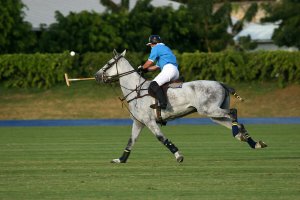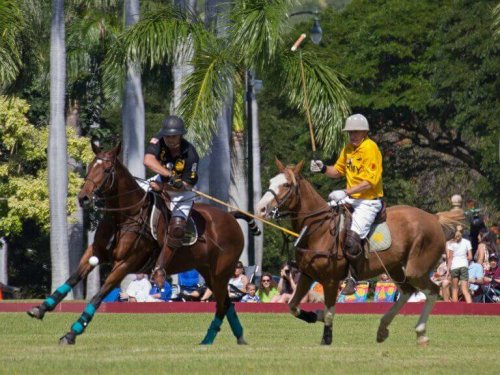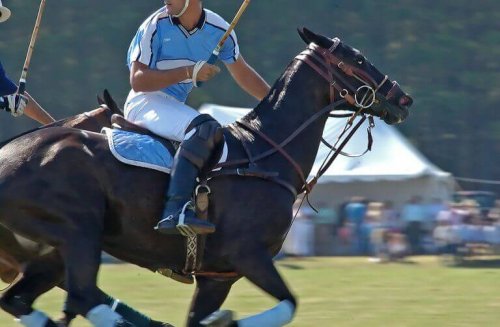All You Need to Know About the Sport of Polo

The origin of the sport of polo is in Central Asia but it’s actually more prevalent in Argentina. In order to play polo, you need two teams with four players each who are riding horses.
This is a sport where there are two teams with four players on horses. The objective is to hit a wooden ball with a mallet (also called a stick) to score goals in the opposite goal cage. Continue reading to find out more about polo.
History of polo
Polo is a traditional sport. The first vestiges of the sport began two thousand years ago in Central Asia. Nomads played a sport called chovgan. However, in chovgan the objective was to keep the horses together and entertain the soldiers and the equestrians.
Later, in what today is Iran, (previously Persia), the sport of polo was a game of the royalty and the nobility. Therefore, only the higher classes played polo. Due to the fact that horses are expensive to maintain, only those with money could participate in the sport.
The sport of polo formalized and extended to Tibet where the name changed. The word pulu in the Tibet language means ball. Polo continued to be a game that was a sport of the aristocrats in countries such as China and India.
India is where the British learned to play polo. And they played it not only with horses but with elephants. This was another version of the game. At the end of the 19th century, the sport became popular in Europe and in other countries such as Argentina, Australia, and the United States.
Today, polo is played in almost 80 counties. And since 1987, every four years there is a world championship. One interesting fact: half of the polo players in the world are in Argentina. So naturally, Argentina has won the most world championships.
Specific terms of the sport of polo
When we talk about polo, there are some uncommon words associated with the game. One of these words is handicap. This estimates the number of goals that a player is worth for his team.

For example, a handicap of 14 is the maximum number for a team. Argentina has set this, as they are the leaders in polo. This country portrays a great example of polo at an international level.
Another word that polo players use is chukker, which is a period in the match. Each match has six chukkers of seven minutes each. There’s an interval of three minutes between each one and a 15-minute break after the third one. Also, each match lasts one hour and a half.
To speak like an expert in the world of polo, you should refer to the horses as ponies.
Equipment required for the sport of polo
Every player wears special equipment to play polo. A helmet, riding boots, knee pads, gloves, and elbow pads are all part of the basic uniform. In addition, players wear eye protection too.

Also, every player carries a crop (whip) to control the horse. They also carry a stick made of wood or graphite of a little over 47 inches which they use to hit the ball.
In striking or hitting the ball, there’s a specific technique. The player raises up slightly from the saddle, has the feet firmly in the stirrups and maintains balance with the knees. Besides considering his posture, the player can hit the ball in different ways. It can be straight ahead, it can be backward, or to the left or the right side of the horse.
Of course, throughout history, different players have had their special methods. Such is the case of Juan Carlos Harriott, an Argentine player. Harriott was one of the best in the history of polo, On occasion, he made a backhand hit that went between the legs of the horse.
If you’d like to learn more about polo, you could go to a polo match or watch a world championship on TV. If you live or have the opportunity to go to Argentina, you can enjoy the best polo in the world in the Argentinian Open, which is every December.
The origin of the sport of polo is in Central Asia but it’s actually more prevalent in Argentina. In order to play polo, you need two teams with four players each who are riding horses.
This is a sport where there are two teams with four players on horses. The objective is to hit a wooden ball with a mallet (also called a stick) to score goals in the opposite goal cage. Continue reading to find out more about polo.
History of polo
Polo is a traditional sport. The first vestiges of the sport began two thousand years ago in Central Asia. Nomads played a sport called chovgan. However, in chovgan the objective was to keep the horses together and entertain the soldiers and the equestrians.
Later, in what today is Iran, (previously Persia), the sport of polo was a game of the royalty and the nobility. Therefore, only the higher classes played polo. Due to the fact that horses are expensive to maintain, only those with money could participate in the sport.
The sport of polo formalized and extended to Tibet where the name changed. The word pulu in the Tibet language means ball. Polo continued to be a game that was a sport of the aristocrats in countries such as China and India.
India is where the British learned to play polo. And they played it not only with horses but with elephants. This was another version of the game. At the end of the 19th century, the sport became popular in Europe and in other countries such as Argentina, Australia, and the United States.
Today, polo is played in almost 80 counties. And since 1987, every four years there is a world championship. One interesting fact: half of the polo players in the world are in Argentina. So naturally, Argentina has won the most world championships.
Specific terms of the sport of polo
When we talk about polo, there are some uncommon words associated with the game. One of these words is handicap. This estimates the number of goals that a player is worth for his team.

For example, a handicap of 14 is the maximum number for a team. Argentina has set this, as they are the leaders in polo. This country portrays a great example of polo at an international level.
Another word that polo players use is chukker, which is a period in the match. Each match has six chukkers of seven minutes each. There’s an interval of three minutes between each one and a 15-minute break after the third one. Also, each match lasts one hour and a half.
To speak like an expert in the world of polo, you should refer to the horses as ponies.
Equipment required for the sport of polo
Every player wears special equipment to play polo. A helmet, riding boots, knee pads, gloves, and elbow pads are all part of the basic uniform. In addition, players wear eye protection too.

Also, every player carries a crop (whip) to control the horse. They also carry a stick made of wood or graphite of a little over 47 inches which they use to hit the ball.
In striking or hitting the ball, there’s a specific technique. The player raises up slightly from the saddle, has the feet firmly in the stirrups and maintains balance with the knees. Besides considering his posture, the player can hit the ball in different ways. It can be straight ahead, it can be backward, or to the left or the right side of the horse.
Of course, throughout history, different players have had their special methods. Such is the case of Juan Carlos Harriott, an Argentine player. Harriott was one of the best in the history of polo, On occasion, he made a backhand hit that went between the legs of the horse.
If you’d like to learn more about polo, you could go to a polo match or watch a world championship on TV. If you live or have the opportunity to go to Argentina, you can enjoy the best polo in the world in the Argentinian Open, which is every December.
All cited sources were thoroughly reviewed by our team to ensure their quality, reliability, currency, and validity. The bibliography of this article was considered reliable and of academic or scientific accuracy.
- Elma Caballero González Gordón. Breves notas sobre la historia del polo internacional y español. Real Federación Española de Polo. http://rfepolo.org/wp-content/uploads/2013/05/historia-polo.pdf
This text is provided for informational purposes only and does not replace consultation with a professional. If in doubt, consult your specialist.








